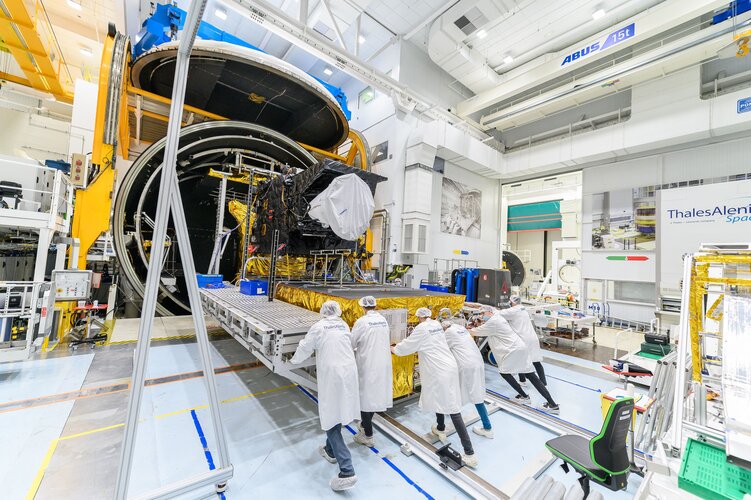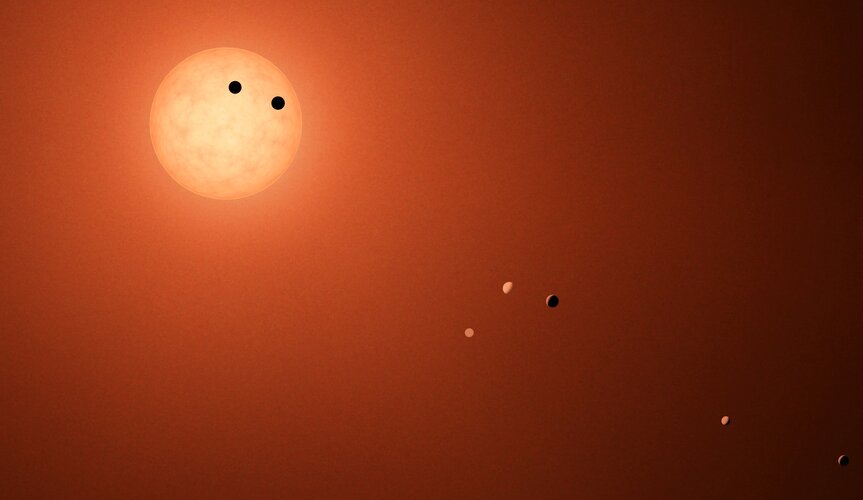
Copernical Team
Spaceflight Inc and Astrocast Extend Launch Contract
 Spaceflight Inc., the leading global launch services provider, has announced an extended multi-launch agreement (MLA) with long-time customer, Internet of Things (IoT) constellation developer, Astrocast. This agreement will add two missions to accommodate Astrocast's fast-growing IoT constellation which helps track assets in some of the world's most remote regions.
In February of 2020, Ast
Spaceflight Inc., the leading global launch services provider, has announced an extended multi-launch agreement (MLA) with long-time customer, Internet of Things (IoT) constellation developer, Astrocast. This agreement will add two missions to accommodate Astrocast's fast-growing IoT constellation which helps track assets in some of the world's most remote regions.
In February of 2020, Ast Lettuce could protect astronauts' bones on Mars trip
 Astronauts might one day grow and eat genetically modified plants to ward off disease associated with long spaceflights. Researchers at the University of California, Davis College of Engineering have developed a transgenic, or genetically modified, lettuce producing a drug to protect against bone density loss in microgravity. The work will be presented March 22 at the Spring meeting of the Ameri
Astronauts might one day grow and eat genetically modified plants to ward off disease associated with long spaceflights. Researchers at the University of California, Davis College of Engineering have developed a transgenic, or genetically modified, lettuce producing a drug to protect against bone density loss in microgravity. The work will be presented March 22 at the Spring meeting of the Ameri Mini robots practise grasping space debris
 A challenging feat for a little robot: Honey the Astrobee must grasp and transport Bumble the Astrobee. To pull it off, Honey needs to understand Bumble's trajectory, position itself correctly and avoid a collision at all costs. Artificial intelligence (AI) helps the cube-shaped robot to accurately assess the situation. The experiment is part of the TumbleDock/ROAM project, which the German Aero
A challenging feat for a little robot: Honey the Astrobee must grasp and transport Bumble the Astrobee. To pull it off, Honey needs to understand Bumble's trajectory, position itself correctly and avoid a collision at all costs. Artificial intelligence (AI) helps the cube-shaped robot to accurately assess the situation. The experiment is part of the TumbleDock/ROAM project, which the German Aero Rocket Lab to Launch Three Demonstration Satellites for E-Space
 Rocket Lab USA (Nasdaq: RKLB) will launch three demonstration satellites for E-Space, to validate the systems and technology for its satellite system. The satellites are scheduled to fly as part of a rideshare mission on Rocket Lab's Electron launch vehicle from Launch Complex 1 Pad A on New Zealand's Mahia Peninsula expected in the second quarter of 2022.
E-Space aims to reduce the launch
Rocket Lab USA (Nasdaq: RKLB) will launch three demonstration satellites for E-Space, to validate the systems and technology for its satellite system. The satellites are scheduled to fly as part of a rideshare mission on Rocket Lab's Electron launch vehicle from Launch Complex 1 Pad A on New Zealand's Mahia Peninsula expected in the second quarter of 2022.
E-Space aims to reduce the launch MTG-I weather satellite passes tests in preparation for liftoff

With extreme weather events threatening to be more frequent and more severe as the climate crisis takes grip, it’s never been more important to have fast and accurate forecasts. ESA and Eumetsat are working hard to ensure that there will be a constant stream of weather data from space for the next decades and that these data will arrive faster and be more accurate compared to what we have today. It is therefore fitting that on World Meteorological Day, ESA can be assured that the first of the next generation weather satellites, Meteosat Third Generation
NASA's Roman mission will test competing cosmic acceleration theories

Video: What are the Trojan asteroids?
Use this form if you have come across a typo, inaccuracy or would like to send an edit request for the content on this page. For general inquiries, please use our contact form. For general feedback, use the public comments section below (please adhere to guidelines).
Please select the most appropriate category to facilitate processing of your request
A research study analyzes the characteristics of Apophis, the asteroid that will approach Earth in 2029

The study, in which the Universidad Carlos III de Madrid (UC3M) and the Universidad Estatal Paulista Júlio de Mesquita Filho (Júlio de Mesquita Filho Paulista State University) (UNESP) of Brazil are participating, analyzes the surface and dynamics of Apophis, an asteroid that will pass close to Earth in 2029.
The Apophis asteroid was discovered in 2004 and has been monitored since then due to its classification as a potentially hazardous asteroid (PHA), as it was estimated that it would have a 2% chance of hitting Earth. This possibility has already been ruled out and, according to the latest measurements, Apophis will reach its closest trajectory to Earth (38,000 kilometers) on the 13th of April, 2029.
This study analyzes the physical characteristics of this celestial body and the possible effects that its approach to Earth may have. Gabriel Borderes-Motta, a researcher at UC3M's Department of Bioengineering and Aerospace Engineering, explains that "collision is not the only possibility in approach events like this one. The gravitational interaction between a planet and a body such as Apophis can change the shape of the body, break the body into pieces, disintegrate possible loose stones on the asteroid's surface, or even remove other bodies orbiting the asteroid (such as rocks, satellites, or rings).
Settle the TRAPPIST exoplanets: challenge for evolutionary computing

It reads like a work of science fiction: software that mates, reproduces and mutates being deployed to plan the exploration and settlement of the exotic TRAPPIST-1 solar system, around 40 light years away from Earth. In fact this is the latest competition conceived by ESA’s Advanced Concepts Team, this time seeking to challenge the worldwide evolutionary computing community.
Satellite navigation signals help map sea surface shape
 Video:
00:05:00
Video:
00:05:00
Monitoring the constantly changing shape of the sea surface is important for scientific and societal applications such as ocean current forecasting, climate research, ship routing, cable laying, and debris tracking.
A project supported by the Discovery element of ESA’s Basic Activities recently investigated a new technique to measure sea surface topography very precisely. The project was based on an idea submitted by the Institute for Space Studies of Catalonia (IEEC) through the Open Space Innovation Platform (OSIP) – ESA’s place for your space ideas.
The technique involves looking at satellite navigation (GNSS) signals that have been reflected off of






























